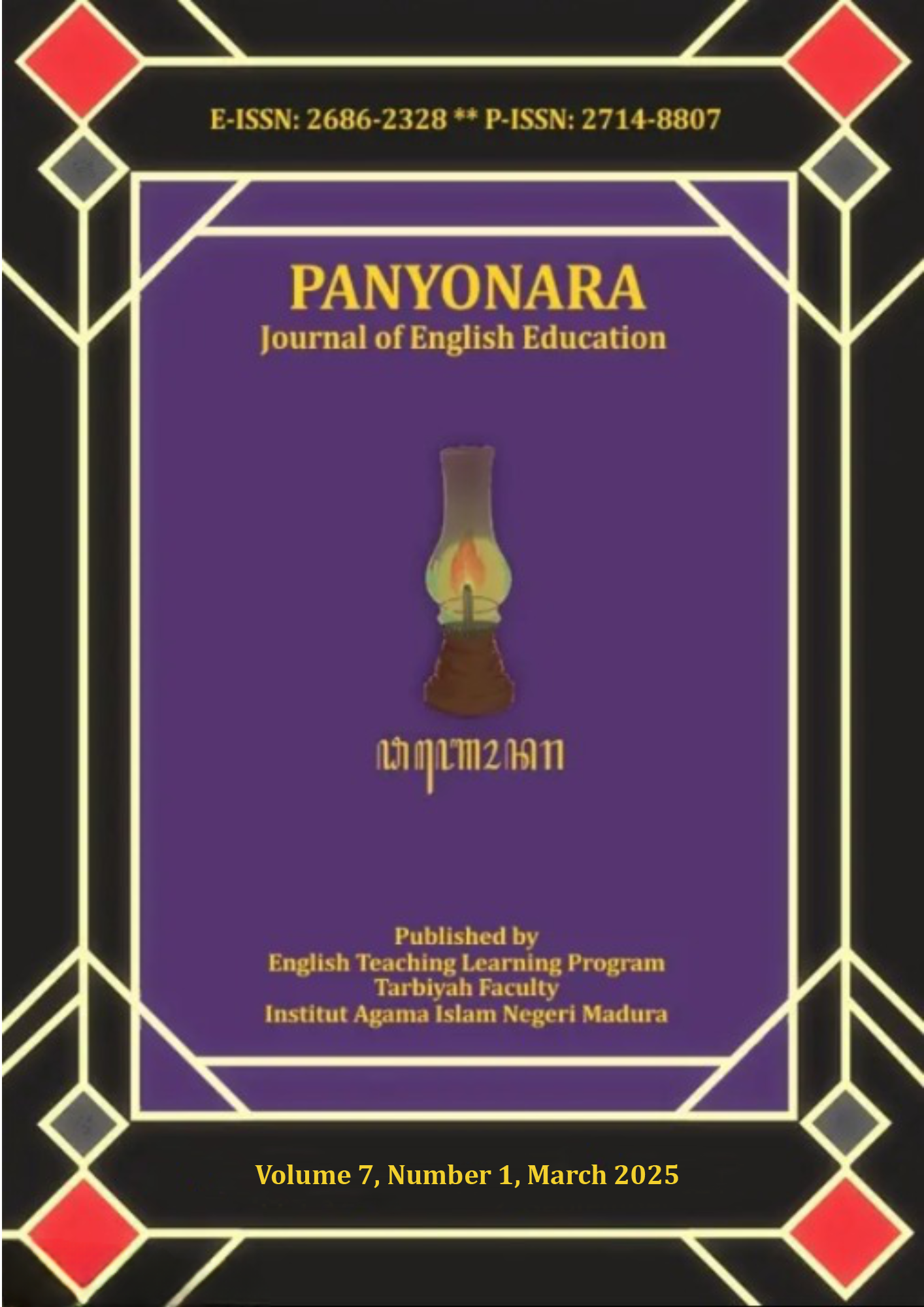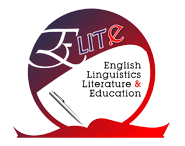Using a Digital Multimodal-Google Sites to Enhance Students' Reading Comprehension Proficiency in Narrative Text
 Abstract views: 64
,
Abstract views: 64
,
 PDF downloads: 38
PDF downloads: 38
Abstract
This study discusses students' challenges in reading narrative texts. In this study, we have discussed the effectiveness test of the Google Sites digital multimodal platform to improve students' comprehension in reading. This study used pre-experimental approach with a single-group pretest-posttest design. The subjects of this study were 79 ninth-grade students at SMP Ma’had Islam Semarang. They were selected using purposive sampling. In this method. Iit systematically explored basic comprehension through pretests, intervened students using Google Sites, and ended with a posttest to determine the improvement in reading comprehension achieved by students. The main findings of this study show an increase in students' understanding in reading narrative texts through the Google Sites digital multimodal platform. So it can be concluded that Google Sites' learning tools are significant for improving the reading comprehension of narrative texts. The limitation of this study is the absence of a control group, but the results of the study show that this method approach is highly recommended to maximize students' reading comprehension instruction.
Downloads
References
Adams, B., Wilson, N. S., Dussling, T., Stevens, E. Y., Van Wig, A., Baumann, J., Yang, S., Mertens, G. E., Bean-Folkes, J., & Smetana, L. (2023). Literacy’s Schrödinger’s cat: capturing reading comprehension with social annotation. Teaching Education, 34(4), 367–383. https://doi.org/10.1080/10476210.2022.2146088
Adlis, Y., Soma, R., & Sufri, S. (2022). Improving Studentsâ€TM Reading Skills in Understanding English Texts Using Culture-Based Text Teaching Materials. Jurnal Basicedu, 6(3), 3665–3673. https://doi.org/10.31004/BASICEDU.V6I3.2695
Allagui, B. (2022). Facilitating Creativity through Multimodal Writing: An Examination of Students’ Choices and Perceptions. Creativity, 9(1), 108–129. https://doi.org/10.2478/CTRA-2022-0006
Alqahtani, S. S. (2023). Ipad Text-to-Speech and Repeated Reading to Improve Reading Comprehension for Students with SLD. Reading & Writing Quarterly, 39(1), 1–15. https://doi.org/10.1080/10573569.2021.1987363
Anggraeni, A. D., & Pentury, H. J. (2020). Using Educational Digital Toolbox in E-Learning to Boost Students’ Reading Motivation in Covid-19 Pandemic. RETORIKA: Jurnal Bahasa, Sastra, Dan Pengajarannya, 13(2). https://doi.org/10.26858/RETORIKA.V13I2.13538
Baroni, R., Goudmand, A., & Ryan, M.-L. (2023). Transmedial Narratology and Transmedia Storytelling. The Palgrave Handbook of Intermediality, 1–25. https://doi.org/10.1007/978-3-030-91263-5_16-1
Binti, F., Chasanah, A., & Wachidah, K. (2024). Memperkuat Keterampilan Membaca Awal Melalui Permainan Bahasa Kartasis. Jurnal Pendidikan Guru Sekolah Dasar, 1(4), 1–15. https://doi.org/10.47134/PGSD.V1I4.714
Chatman, S. (1978). Story and Discourse: Narrative Structure in Fiction and Film. In Cornell University Press. https://ia902900.us.archive.org/4/items/StoryAndDiscourseNarrativeStructureInFictionAndFilm/chatman.seymour_story.and.discourse_narrative.structure.in.fiction.and.film1.pdf
Cohen, D. L. D., & McIntyre, D. A. (2024). Integrating Technology in Elementary Education: Enhancing Student Engagement in the Digital Age. International Education and Research Journal (IERJ), 10(8). https://doi.org/10.21276/IERJ24297768747793
Creswell., J. W. (2017). Research Design: Qualitative, Quantitative, and Mixed Methods Approaches - John W. Creswell - Google Buku. SAGE Publications. https://books.google.co.id/books?id=4uB76IC_pOQC&printsec=copyright&hl=id#v=onepage&q&f=false
Culajara, C. J., & Catalina, S. (2022). Maximizing the Use of Google Sites in Delivering Instruction in Physical Education Classes. Physical Education and Sports: Studies and Research, 1(2), 79–90. https://doi.org/10.56003/PESSR.V1I2.115
De Corte, E., Verschaffel, L., & De Ven, A. Van. (2001). Improving text comprehension strategies in upper primary school children: A design experiment. British Journal of Educational Psychology, 71(4), 531–559. https://doi.org/10.1348/000709901158668
Devecioglu-Kaymakci, Y. (2016). Embedding Analogical Reasoning into 5E Learning Model: A Study of the Solar System. Eurasia Journal of Mathematics, Science and Technology Education, 12(4), 881–911. https://doi.org/10.12973/EURASIA.2016.1266A
Du Bois, I. (2024). 11. Multimodalität in der digitalen Kommunikation: Memes und digitaler Humor. Handbuch Sprache Und Digitale Kommunikation, 225–246. https://doi.org/10.1515/9783110744163-011/HTML
Farihah, E. N., Chotimah, C., & Tamela, dan E. (2023). An Analysis of Students’ Reading Comprehension in Narrative Text. Channing, 8(2), 48–55. https://doi.org/10.30599/CHANNING.V8I2.2786
Fontaine, G., Zagury-Orly, I., Maheu-Cadotte, M. A., Lapierre, A., Thibodeau-Jarry, N., de Denus, S., Lordkipanidzé, M., Dupont, P., & Lavoie, P. (2021). A meta-analysis of the effect of paper versus digital reading on reading comprehension in health professional education. American Journal of Pharmaceutical Education, 85(10), 1075–1084. https://doi.org/10.5688/ajpe8525
Gao, Y. (2022). An Evaluation of the Application of Mixed Research Methods in Educational Research. International Journal of New Developments in Education, 4(6), 89–93. https://doi.org/10.25236/IJNDE.2022.040615
Gnach, A., Weber, W., Engebretsen, M., & Perrin, D. (2022). Digital Communication and Media Linguistics: With Case Studies in Journalism, PR, and Community Communication. Digital Communication and Media Linguistics. https://doi.org/10.1017/9781108780445
Guangli, L. (2024). Design of an Educational Psychology Research Material Sharing Platform Based on Fuzzy Clustering Algorithm. International Journal of High Speed Electronics and Systems. https://doi.org/10.1142/S0129156425400130
Hanan, A., Firman, E., & Putri, A. N. (2022). Investigating English Teachers’ Digital Literacy in the Context of Online Learning. JISIP (Jurnal Ilmu Sosial Dan Pendidikan), 6(3), 2598–9944. https://doi.org/10.58258/JISIP.V6I3.3544
Handayani, S., Youlia, L., Febriani, R. B., & Syafryadin, S. (2020). The Use Of Digital Literature in Teaching Reading Narrative Text. Journal of English Teaching, Applied Linguistics and Literatures (JETALL), 3(2), 65–74. https://doi.org/10.20527/JETALL.V3I2.8445
Herdi, H. (2020). Fourth Semester Students’ Reading Comprehension Ability in Narrative Text Using Online Sources of FKIP Unilak. ELT-Lectura, 7(2), 160–175. https://doi.org/10.31849/ELT-LECTURA.V7I2.4735
Hernadi, P. (1980). On the How, What, and Why of Narrative. Https://Doi.Org/10.1086/448095, 7(1), 201–203. https://doi.org/10.1086/448095
Jeni, Y. (2020). The Using of Short Stories to Enhance Students’ Reading Comprehension. Borneo Educational Journal (Borju), 2(2), 83–88. https://doi.org/10.24903/BEJ.V2I2.632
Jusriati, G. S. (2023). Encouraging Students’ Motivation to Write With Google Site. Afeksi: Jurnal Penelitian Dan Evaluasi Pendidikan, 4(3), 205–213. https://doi.org/10.35672/AFEKSI.V4I3.104
Khaerani, K., Syamsuriyawati, S., & Rahmawati, R. (2024). Efektivitas Penggunaan Bintang Ajaib Sebagai Alat Peraga Dalam Pemahaman Konsep Barisan Aritmatika Siswa kelas VII SMP YP PGRI 4 Makassar. EQUALS: Jurnal Ilmiah Pendidikan Matematika, 7(1), 55–62. https://doi.org/10.46918/EQUALS.V7I1.2220
Knoop-van Campen, C. A. N., ter Doest, D., Verhoeven, L., & Segers, E. (2022). The effect of audio-support on strategy, time, and performance on reading comprehension in secondary school students with dyslexia. Annals of Dyslexia, 72(2), 341–360. https://doi.org/10.1007/S11881-021-00246-W/FIGURES/3
Kurnia, A., & Nasution, P. (2023). Instagram in English Language Learning: A Systematic Literature Review. Journal of Linguistics, Literature, and Language Teaching (JLLLT), 3(1), 33–52. https://doi.org/10.37249/JLLLT.V3I1.708
M, A., & Ruheili, A. (2024). Online Learning Evaluation (Kahoot!) As A Motivational Tool For Students Learning. Educational Administration: Theory and Practice, 30(8), 230–235. https://doi.org/10.53555/KUEY.V30I8.4687
McKibben, E., & Breheny, M. (2023). Making Sense of Making Sense of Time: Longitudinal Narrative Research. Https://Doi.Org/10.1177/16094069231160928, 22. https://doi.org/10.1177/16094069231160928
Mills, K. A., Stone, B. G., Unsworth, L., & Friend, L. (2020). Multimodal Language of Attitude in Digital Composition. Written Communication, 37(2), 135–166. https://doi.org/10.1177/0741088319897978/ASSET/IMAGES/LARGE/10.1177_0741088319897978-FIG10.JPEG
Mohanty, A. K., kumar, S. V. A., Thongam, R., Kawale, S. R., Jakkani, A. K., & G, V. V. (2024). Enhancing Classroom Engagement Through IOT-Enabled Smart Learning Environments. ShodhKosh: Journal of Visual and Performing Arts, 5(1), 1003-1010–1003–1010. https://doi.org/10.29121/SHODHKOSH.V5.I1.2024.2591
Najemi, S., Ardiasih, L. S., & Sundari, H. (2024). The Effectiveness of Google Sites in Differentiated Instruction to Increase Students’ Learning Motivation and Reading Comprehension on English Narrative Texts. ELT-Lectura, 11(2), 110–122. https://doi.org/10.31849/ELT-LECTURA.V11I2.21768
Nayeri, N. D., Noodeh, F. A., Nia, H. S., Yaghoobzadeh, A., Allen, K. A., & Goudarzian, A. H. (2023). Statistical Procedures Used in Pretest-Posttest Control Group Design: A Review of Papers in Five Iranian Journals. Acta Medica Iranica, 61(10), 584–591. https://doi.org/10.18502/ACTA.V61I10.15657
Othman, Y., & Mustapha, G. (2010). Comprehension Process in Metacognitive Perspective Among University Students. EDUCARE, 2(2), 2010. https://doi.org/10.2121/EDU-IJES.V2I2.218
Podhovnik, E. (2023). Multimeowdality. Purrieties of Language, 138–172. https://doi.org/10.1017/9781108918909.006
Radaideh, E., Al-Jamal, D., & Imad Sa’di. (2020). Digital Storytelling: Time to be Considered in Reading Comprehension. Universal Journal of Educational Research, 8(6), 2621–2633. https://doi.org/10.13189/UJER.2020.080645
Roblyer, M. D. ., & Doering, A. H. (2013). Integrating educational technology into teaching. Pearson/Allyn and Bacon Publishers. https://books.google.com/books/about/Integrating_Educational_Technology_Into.html?hl=id&id=Lk7SXwAACAAJ
Royandi, M. A., & Hung, J. P. (2022). Design of an Affordable Cross-Platform Monitoring Application Based on a Website Creation Tool and Its Implementation on a CNC Lathe Machine. Applied Sciences 2022, Vol. 12, Page 9259, 12(18), 9259. https://doi.org/10.3390/APP12189259
Saçak, B. (2021). Multimodal Social Semiotics and Learning Design: In Search of Interdisciplinarity. 43–52. https://doi.org/10.1007/978-3-030-53875-0_4
Septianingrum, J., Budiyanto, M., & Qosyim, A. (2024). Implementasi Model Pembelajaran Inkuiri Terbimbing untuk Meningkatkan Keterampilan Proses Sains Siswa SMP. EDUKATIF : Jurnal Ilmu Pendidikan, 6(4), 3952–3961. https://doi.org/10.31004/EDUKATIF.V6I4.7444
Siregar, E. S., Kurniati, R., & Rahayu, S. (2022). Multimedia as a Learning Tool in Training Reading Skills of Elementary Schools Students. Journal of Education Technology, 6(2), 299–307. https://doi.org/10.23887/JET.V6I2.44601
Snow, C. E. (2010). Reading Comprehension: Reading for Learning. International Encyclopedia of Education, Third Edition, 413–418. https://doi.org/10.1016/B978-0-08-044894-7.00511-X
Songkhro, J., Dequiña, Jr., L. S., Dominguez, R. R., & Phanlapa Khathayut, P. (2022). Effectiveness of Using Animated Videos via Google Sites in Enhancing Socio-culture of Native English-Speaking Countries. Education Quarterly Reviews, 5(2). https://doi.org/10.31014/AIOR.1993.05.02.497
Spiro, R. J., Bruce, B. C., & Brewer, W. F. (2018). Theoretical Issues in Reading Comprehension: Perspectives from Cognitive ... - Google Buku. https://books.google.co.id/books?id=Srw8DwAAQBAJ&printsec=frontcover&source=gbs_ge_summary_r&cad=0#v=onepage&q&f=false
Staskowski, M., & Creaghead, N. A. (2001). Reading comprehension: A language intervention target from early childhood through adolescence. Seminars in Speech and Language, 22(3), 185–194. https://doi.org/10.1055/S-2001-16198/ID/13/BIB
Stawarska, B. (2020). Beyond the Doctrine: Linguistic Innovation. In Saussure’s Linguistics, Structuralism, and Phenomenology (pp. 77–85). Palgrave Macmillan, Cham. https://doi.org/10.1007/978-3-030-43097-9_9
Sutrisno, D., Abidin, N. A. Z., Pambudi, N., Aydawati, E., & Sallu, S. (2023). Exploring the Benefits of Multimodal Literacy in English Teaching: Engaging Students Through Visual, Auditory, and Digital Modes. Global Synthesis in Education Journal, 1(2), 1–14. https://doi.org/10.61667/XH184F41
Vidal, M. P. (2022). Effectiveness of Multimedia and Text-Based Reading Approaches to Grade 10 Students’ Reading Comprehension Skills. AsiaCALL Online Journal, 13(4), 55–79. https://doi.org/10.54855/ACOJ.221345
Wadihah, H., & Fauzi, A. (2021). Using Image Media on Reading Text to Improve Reading Comprehension of Student with Intellectual Disabilities. Jurnal Asesmen Dan Intervensi Anak Berkebutuhan Khusus, 21(1), 51–56. https://doi.org/10.17509/JASSI.V21I1.39525
Xiao, J., Lin, T. H., & Sun-Lin, H. Z. (2020). Exploring the Effect of Multichannel Multimodal Learning Environment on Student Motivation and Self-efficacy. Communications in Computer and Information Science, 1302, 164–175. https://doi.org/10.1007/978-981-33-4594-2_14
Zen, Z., Reflianto, R., Ariani, F., & Hidayati, A. (2023). The effect of flipped digital classroom method using moodle and student engagement on reading comprehension. JPPI (Jurnal Penelitian Pendidikan Indonesia), 9(1), 1–11. https://doi.org/10.29210/020232668
The journal uses an Open Access policy under a Creative Commons Attribution-NonCommercial 4.0 International License. Authors who publish with this journal agree to the following terms:
- Authors retain copyright and grant the journal right of first publication with the work simultaneously licensed under a Creative Commons Attribution License that allows others to share the work with an acknowledgment of the work's authorship and initial publication in this journal.
- Authors are able to enter into separate, additional contractual arrangements for the non-exclusive distribution of the journal's published version of the work (e.g., post it to an institutional repository or publish it in a book), with an acknowledgment of its initial publication in this journal.
- Authors are permitted and encouraged to post their work online (e.g., in institutional repositories or on their website) prior to and during the submission process, as it can lead to productive exchanges, as well as earlier and greater citation of published work.
















